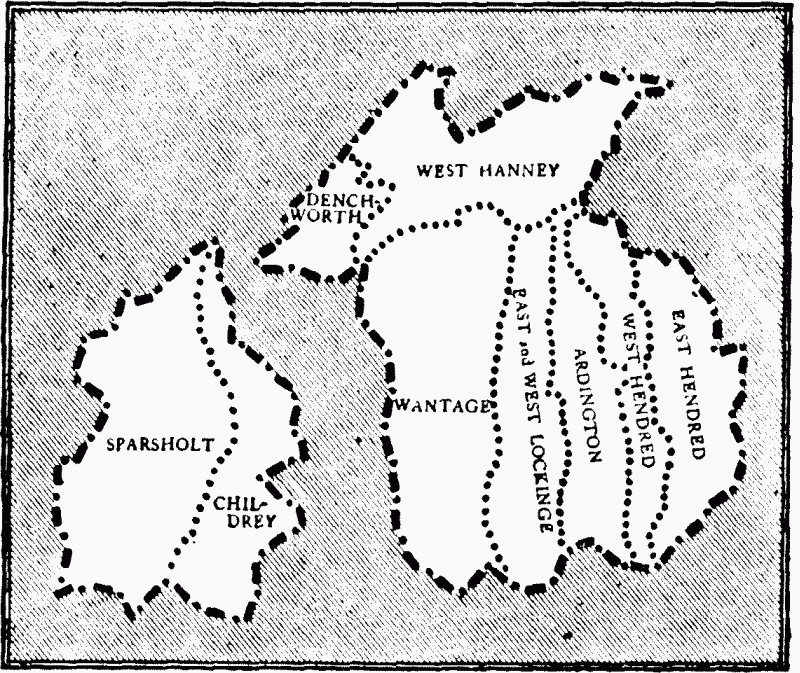A History of the County of Berkshire: Volume 4. Originally published by Victoria County History, London, 1924.
This free content was digitised by double rekeying. All rights reserved.
'Wantage hundred: Introduction', in A History of the County of Berkshire: Volume 4, ed. William Page, P H Ditchfield (London, 1924), British History Online https://prod.british-history.ac.uk/vch/berks/vol4/pp267-268 [accessed 6 May 2025].
'Wantage hundred: Introduction', in A History of the County of Berkshire: Volume 4. Edited by William Page, P H Ditchfield (London, 1924), British History Online, accessed May 6, 2025, https://prod.british-history.ac.uk/vch/berks/vol4/pp267-268.
"Wantage hundred: Introduction". A History of the County of Berkshire: Volume 4. Ed. William Page, P H Ditchfield (London, 1924), British History Online. Web. 6 May 2025. https://prod.british-history.ac.uk/vch/berks/vol4/pp267-268.
THE HUNDRED OF WANTAGE
Containing The Parishes Of Ardington; Hanney; East And West Lockinge; Childrey; East Hendred; Sparsholt; Denchworth; West Hendred; Hammey; Wantage
The Domesday hundred of 'Wanetinz' included practically the whole area of the modern hundred, with the addition of 5 hides in Buckland, now in the hundred of Ganfield, and half a virgate in 'Sudtone,' which has not been identified. (fn. 1) The assessment of the whole hundred in the reign of the Confessor had been 224 hides. Ten hides in East Hanney are entered in the Survey under 'Merceham' Hundred (now part of Ock), (fn. 2) and parts of Childrey and Sparsholt under 'Eletesford' (Moreton) Hundred, possibly by mistake. (fn. 3) Two East Hendred manors are placed in 'Sudtone' Hundred (fn. 4) (now part of Ock). Since 1831 parts of Denchworth have been placed in Ock Hundred. Kingston Lisle and Fawler in Sparsholt have always been in Shrivenham Hundred.

Index Map to The Hundred Of Wantage
The grant of the manor of Wantage by Richard I to Baldwin de Béthune included soc and sac, tol and theam, infangentheof, utfangentheof, and freedom from suit at shires or hundreds. (fn. 5) There is no record of the grant of the hundred itself to Baldwin, but apparently his successors assumed that both this hundred and that of Ganfield were appurtenant to the manor. Fulk Fitz Warin claimed in 1284 that he held the two by the enfeoffment of William Marshal Earl of Pembroke, whose charter he quoted. (fn. 6) The king's attorney objected that the charter dealt only with the manor of Wantage, and that the hundreds did not belong to any manor. (fn. 7) Nevertheless Fulk and later owners of the manor held the hundred. (fn. 8)
In 1224 Fulk Fitz Warin made an agreement with the Abbot of Abingdon by which the abbot's fair at Shellingford came to an end for the benefit of Fulk's fair at Wantage. Among other concessions he released the abbot and his men from suit at the hundred courts of Wantage and Ganfield. It was agreed that the officers of the hundreds should attend the abbot's court when summoned by his seneschal, and should there hold the view of frankpledge and pleas of the Crown. They were to receive no amercements for offences relating to the hundred. The fines for offences against the Crown were to belong to the abbot. (fn. 9) It is uncertain whether the abbots continued to enjoy this exemption from the ordinary jurisdiction of the hundred. The dispute as to the fair of Shellingford was not finally settled by this agreement. (fn. 10)
A survey of 1651 found that the value of the two hundreds of Wantage and Ganfield, evidently treated as one for purposes of jurisdiction, was £9 2s. 8d. Of this, £6 6s. 8d. represented the profits of the court leet, regularly held at Michaelmas, and the three weeks court, 'usually kept.' The rest of the revenue was made up of certainty money collected by the constables of the various tithings. (fn. 11)